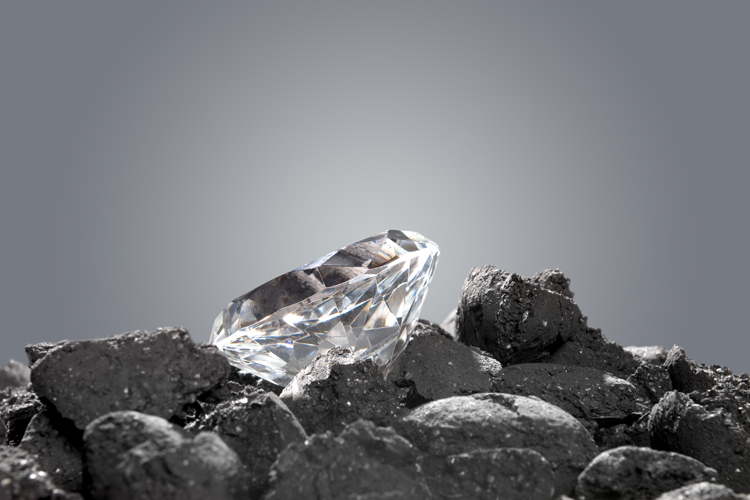The most precious variety of beryl, the emerald, has allured mankind for ages for its incomparable and unique rich green hue, elegance, and mystery.
The name emerald comes from the Greek smaragdos, meaning “green stone.”
This designation appears to have been given to several green gemstones, so the historical references to emeralds may not refer specifically to the present mineral.
The stunning and unique color of emerald, known as “emerald green,” is due to the presence of chromium.
Traces of vanadium may also be present, but beryls colored only by vanadium are not considered emeralds by some gemologists but simply green beryl.
The finest emeralds are transparent.
The most prized tonalities are slightly bluish-green to pure green, and the color should be vivid, saturated, and evenly distributed. A high-quality emerald’s value increases rapidly with size.
Flawless crystals are very uncommon.
Most of the gems are clouded by inclusions, which are named jardin (garden, in French) by the experts because of their mossy-like appearance.
Visible inclusions are usually accepted in the industry, but when they impact negatively on clarity and transparency, they lead to a significant loss of value.
Emerald crystals are hexagonal and occur in schists, limestones, granites, and pegmatites. The finest specimens come from Colombia, but Brazil is also a significant source of emeralds.
Other sources are Zambia, Austria, Zimbabwe, South Africa, the Ural Mountains in Russia, Norway, and North Carolina, USA.
The Cleopatra’s Mines in Upper Egypt are emerald deposits of historical interest since ancient emerald jewelry appears to have come from these deposits.
They were worked in 2,000 BC and became known as “Cleopatra’s Mines” after the conquest of Egypt by Alexander the Great.
The remains of extensive workings were discovered around 1817, but now they only yield poor-quality gems.
Emerald has a hardness of 7,5 to 8 on the Mohs scale. The emerald cut is the most frequent shape for this gem, as it was devised to reduce the loss of valuable material.
Emeralds that are not suitable for faceting or cabochons are sometimes tumble-polished.
Some stones are treated to enhance their color and hide flaws. However, they are less valuable than certified unenhanced high-quality emeralds of the same size, color, and clarity.
The first emerald synthesis was produced in 1848 by Jacques-Joseph-Ebelmen.
Since then, several methods have been developed, and since the 1950s, synthetic gems of excellent quality have been created.
They are often called “created emeralds” and highly resemble natural crystals.
Emerald has been credited with healing and renewal properties throughout history.
The Egyptians viewed the luxurious green stone as a symbol of life, rebirth, and fertility, and the Aztecs called it quetzal, a symbol of seasonal renewal.
Emeralds were believed to heal dysentery, prevent epilepsy and panic, protect from evil spirits, stabilize vision and improve eyesight.
Emerald is also a gemstone of royalty and is present in most royal jewelry collections. The largest collection of natural emeralds in the world is located in the Republic of Bogotá Bank in Columbia.
Famous Emeralds
- The Bahia Emerald: mined in Bahia, Brazil, this is one of the largest emeralds ever found. It weighs about 840 lbs and contains over 180,000 carats. Valued at about 400$ million, the large black schist with nine emerald crystals was at the center of a contentious court battle over its ownership;
- The Mogul Mughal Emerald: weighing 217.80 carats and approximately 10 cm in height, it is one of the largest and most famous emeralds. It is engraved with Shi’a invocations in Naskh script and dates back to 1107 A.H. It was sold by Christie’s for $2,272,400 in 2001 and is now at the Museum of Islamic Art in Qatar;
- The King of Canada Sean Robert Gehani Emerald: it is the largest pear-cut emerald in the world, weighing 36,790 carats;
- The Gachalá Emerald: weighing 858 carats, it is one of the world’s most valuable emeralds. It was discovered in 1967 in Colombia and named after the town of Gachala, where it was mined. The emerald was donated by the jeweler Harry Winston to the Smithsonian Institution;
- The Patricia Emerald: this large, saturated gemstone weighs 632 carats and is viewed as one of the most remarkable emeralds in the world. It was discovered in Colombia in 1920 and named after the mine owner’s daughter;
Emerald | Physical Properties
Chemical Composition: Be3 Al2 Si6 018
Cleavage: Indistinct/Imperfect
Color: Green
Crystal System: Hexagonal
Fracture: Uneven to Conchoidal
Luster: Vitreous
Mohs Hardness: 7.5-8
Specific Gravity: 2.6-3.0
Transparency: Transparent to Translucent




